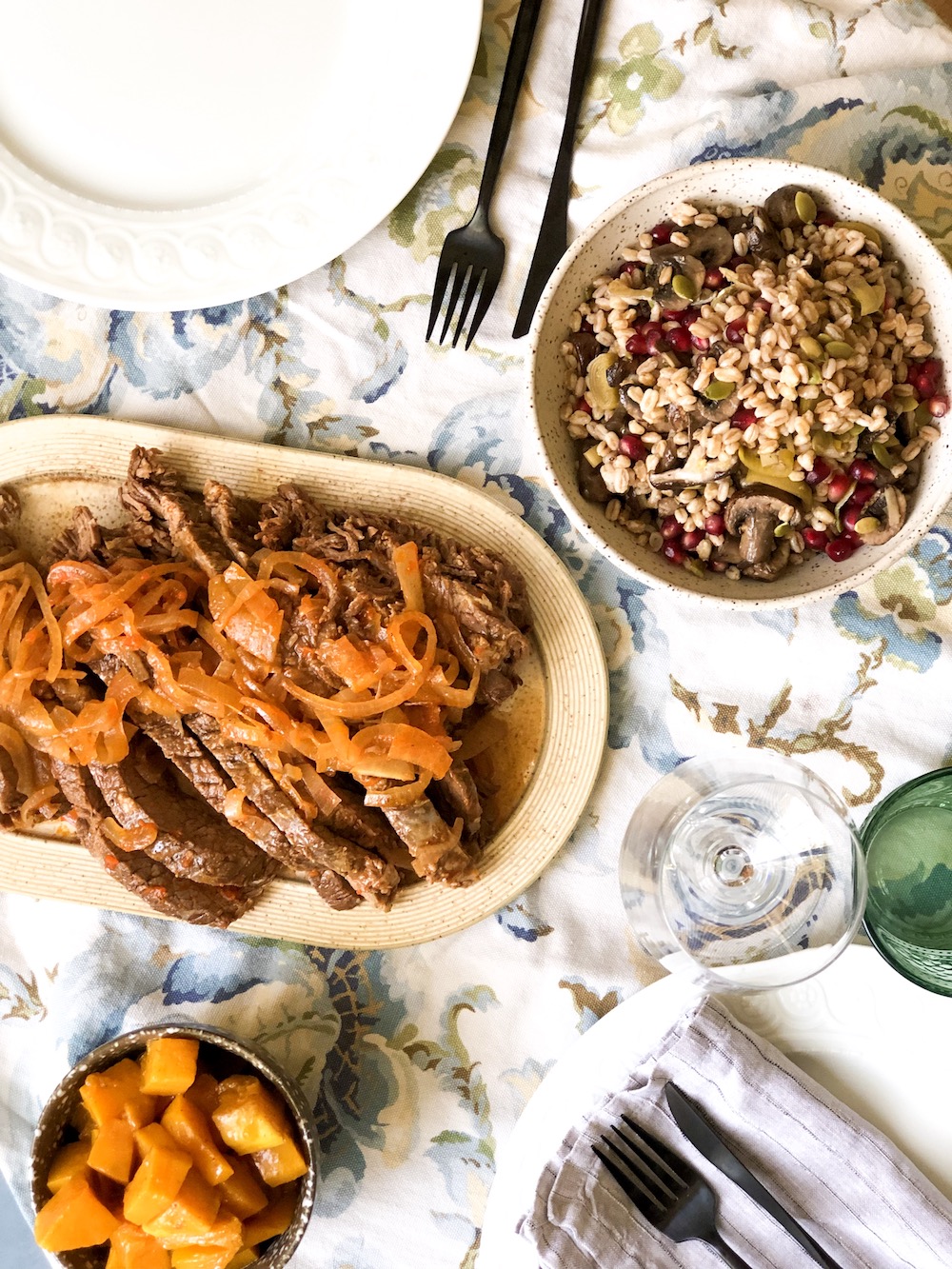
Brisket is one of my go-to recipes to make for a large party, especially when I need something easy. The rich, smoky flavor and tender texture of brisket make it a crowd-pleaser every time. Whatever type of event you’re hosting, whether that be a backyard barbecue, a family gathering, or a special occasion, serving brisket is a surefire way to impress your guests. But when it comes to estimating how much brisket do you need per person, there are a few factors to consider, and it’s essential that everyone is satisfied with their portion without going overboard.
So let me share how I portion brisket, how I accommodate other dietary needs, and some favorite sides that go great with it. Let’s get started.
The Brisket Rule of Thumb
When it comes to estimating how much meat you need per person, the “brisket rule of thumb” can be a helpful starting point. As a general guideline, a serving size of brisket is typically about ½ to ¾ pound of uncooked brisket per adult and ¼ to ⅓ pound of uncooked brisket per child. This estimation considers both the cooked weight and the boneless, trimmed brisket. But don’t forget; it’s important to remember that individual preferences and appetites vary.
Let’s do some simple calculations based on the information provided. Assuming you have 10 guests (6 adults and 4 children) and you want to allocate ½ pound of uncooked brisket per adult and ¼ pound per child, the total amount of uncooked brisket needed would be:
- 6 adults * 0.5 pounds/adult = 3 pounds of raw brisket
- 4 children * 0.25 pounds/child = 1 pound of raw brisket
That is a total of 4 lbs of brisket (uncooked).
When estimating how many pounds of cooked brisket you need, it’s important to consider the desired serving size and the amount of shrinkage that occurs during the cooking process. As a good rule of thumb, you can estimate that when cooking brisket, the cooked weight will be approximately 50–60% of the uncooked weight.
If you’re hosting a dinner party or gathering, consider your guest list and the number of guests you’ll be serving. For large groups, lean towards the lower end of the serving range so that there’s enough to go around. This way, you can avoid the disappointment of running out. On the other hand, if you’re hosting a smaller, more intimate gathering, you can be more generous with the portion sizes.
In addition to the number of people, it’s also important to consider the overall menu and what other protein options there will be on the table. If you’re planning a feast with a variety of main dishes and side dishes, you can lean towards the lower end of the serving range. This allows your guests to sample different flavors and textures without feeling overwhelmed by the amount of brisket on their plates. However, if it is the main course, you might want to lean towards the higher end of the serving range to make sure that everyone gets their fill.
Make sure to also take into account the occasion and the desired atmosphere of your gathering. If you’re hosting a casual backyard barbecue or a relaxed get-together, you can be more flexible with the portion sizes. However, for more formal events or special occasions, it’s important to make sure that each guest receives an ample portion of brisket. It’s always a good idea to know your guests’ preferences, and the best way is to take into account any dietary restrictions or preferences they may have.
Considering Appetites
Another important factor to consider when estimating how much brisket you need per person is the appetites of your guests. Understanding their preferences and taking into account their eating habits can help you determine the ideal serving size.
If you have a group of big eaters or you know your guests have a particular fondness for brisket, you might want to lean towards the higher end of the serving range. This way, you can make sure that you have plenty of food on the table and everyone is satisfied.
However, if you’re serving a more diverse menu with other protein options, you can lean toward the lower end of the serving range. This allows your guests to sample a variety of dishes without feeling overwhelmed by the amount of brisket on their plate. It’s all about finding the right balance and creating a well-rounded dining experience.
Accounting for Brisket Leftovers
Leftover brisket is always a delicious bonus that adds versatility to your meal planning. Whether you plan to use it for sandwiches, and tacos or simply enjoy it again the next day, it’s worth erring on the side of caution and factoring in extra brisket for potential leftovers. Allocating an additional ¼ to ½ pound of brisket per person ensures that there’s enough for seconds or to enjoy in different ways throughout the week.
The beauty of leftover brisket is its ability to be transformed into various delicious dishes. From hearty brisket sandwiches piled high with tender slices of meat to flavorful tacos topped with your favorite toppings, the possibilities are endless. You can also use the leftover brisket as a topping for salads, and pizzas, or even incorporate it into pasta dishes for a delightful twist.
If you’re unsure about the preferences of your guests or if you’re hosting a potluck-style gathering where everyone brings a dish, it’s a good idea to check with your guests in advance. This way, you can get a better idea of how much brisket to prepare and whether any dietary restrictions or preferences need to be taken into account.
Leftover brisket not only saves you time and effort in the kitchen but also allows you to savor the flavors of your delicious meal beyond the initial serving. So, when estimating how much brisket you need per person, don’t forget to factor in that extra amount for leftovers. It’s a great way to make the most of your brisket and enjoy it in different ways throughout the week.
What to serve with Brisket
When serving, let’s talk about side dishes. Choosing the right side dishes can elevate your meal and create a well-rounded experience. The good thing is that there are so many options. From classic options like barbecue sauce, potato salad, and coleslaw to more creative choices like roasted vegetables or quinoa salad, there are plenty of delicious side dishes that can complement the rich and savory flavors. Whether you prefer traditional favorites or want to experiment with new flavors, the right side dishes can enhance the overall enjoyment of your feast.
- Potato Kugel: A classic Jewish dish, potato kugel is made with grated potatoes, onions, eggs, and seasonings. It has a crispy exterior and a soft, flavorful interior, making it a perfect accompaniment to brisket.
- Roasted Root Vegetables: Roasting a medley of root vegetables like carrots, parsnips, and sweet potatoes with olive oil, herbs, and spices creates a flavorful and hearty side dish that complements the richness of the brisket.
- Matzo Ball Soup: A beloved Jewish comfort food, matzo ball soup is made with matzo meal, eggs, and seasonings. Serving this warm and comforting soup adds a traditional touch to the meal.
- Braised Red Cabbage: Slow-cooked red cabbage with apples, onions, and a touch of vinegar creates a tangy and sweet side dish that pairs well with the savory flavors of brisket.
- Quinoa Salad: A light and refreshing option, quinoa salad with fresh vegetables, herbs, and a citrus dressing provides a nutritious and flavorful side dish that complements the richness of the brisket.
- Challah Rolls: Serving freshly baked challah rolls alongside the meal adds a traditional and comforting element to the meal. The soft and fluffy texture of the rolls is perfect for sopping up any juices from the brisket.
Special Considerations for Non-brisket Eaters
If you have any vegetarian or vegan guests attending your gathering, it’s important to consider their dietary preferences and offer alternative options to ensure that everyone can enjoy a delicious meal and help you factor in how much food you’ll need. By providing a variety of plant-based dishes alongside the brisket, you can create a welcoming and inclusive dining experience for all.
Grilled vegetables are a great choice to complement the smoky flavors of the brisket. You can prepare a colorful medley of bell peppers, zucchini, eggplant, and onions, seasoned with herbs and spices, and grilled to perfection. The charred edges and tender texture of the vegetables will provide a delightful contrast to the rich and savory flavors.
Tofu dishes can also be a great addition to the menu, offering a protein-packed alternative for your vegetarian or vegan guests. Marinated and grilled tofu skewers or crispy tofu bites can provide a satisfying and flavorful option that pairs well with the brisket. By incorporating different seasonings and sauces, you can create a variety of tofu dishes that cater to different taste preferences.
Remember, these serving guidelines are just rough estimates. Ultimately, it’s best to know your guests’ preferences and take into account any other dishes you’ll be serving alongside the brisket. By offering a variety of options, you can ensure that everyone feels included and can enjoy a delicious meal that suits their dietary choices.
With these suggestions in mind, you can confidently plan your meal, making sure that there’s enough meat for the lovers and a good array of vegetarian and vegan options for those with different dietary preferences. By creating a diverse and inclusive menu, you’ll be able to host a memorable gathering where everyone can come together and enjoy a fantastic meal.
Now that you have a better understanding of how much brisket you’ll need per person, it’s time to put that knowledge to use. We hope this serving guide has helped plan your next brisket feast. Enjoy your meal and happy cooking!





